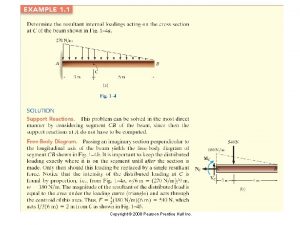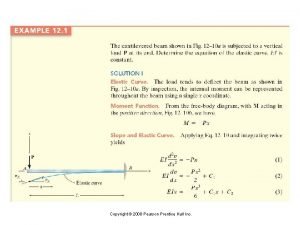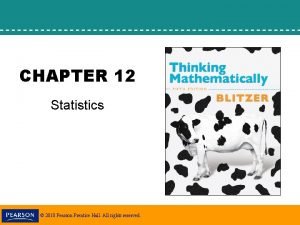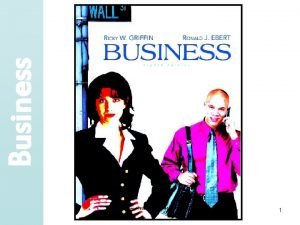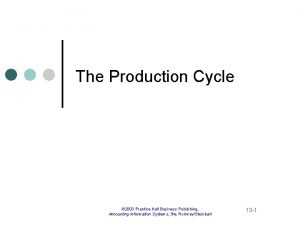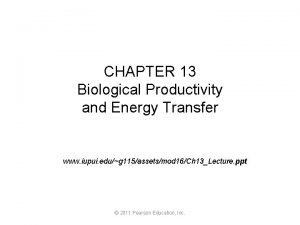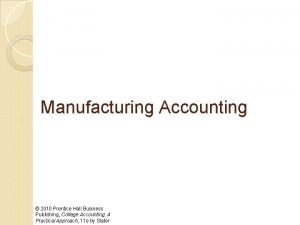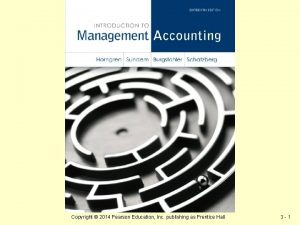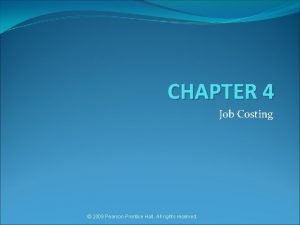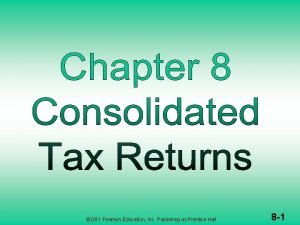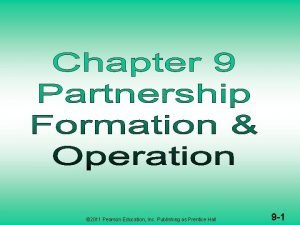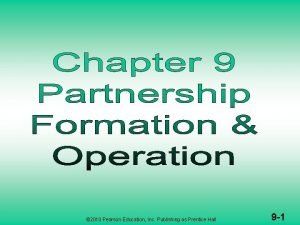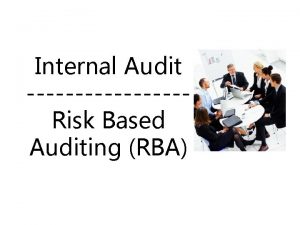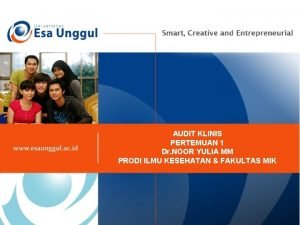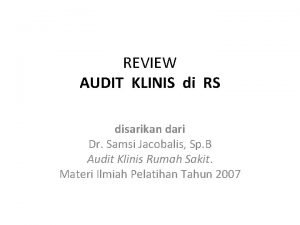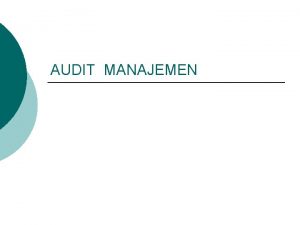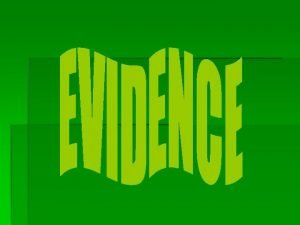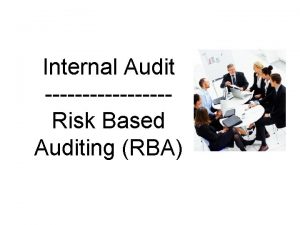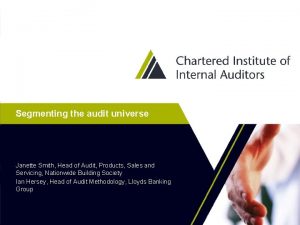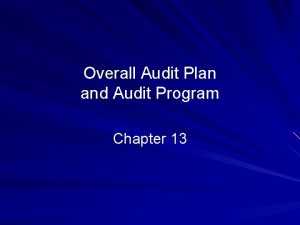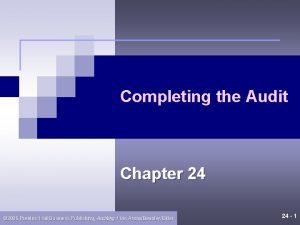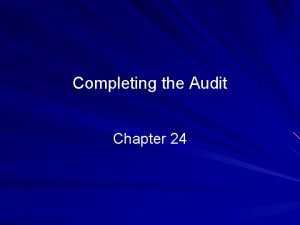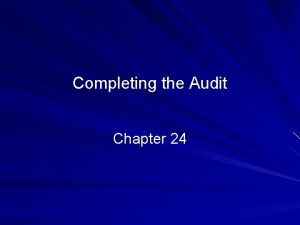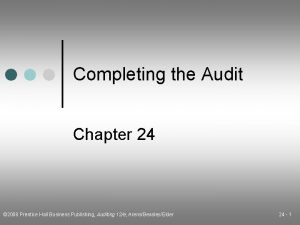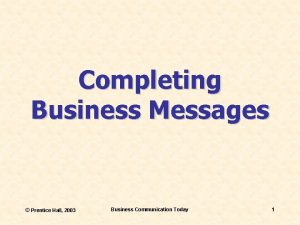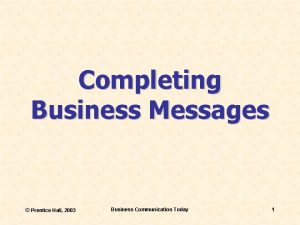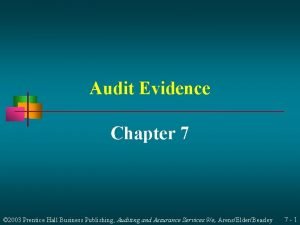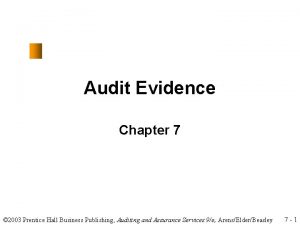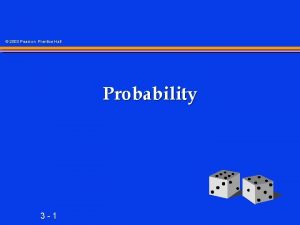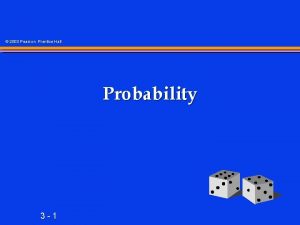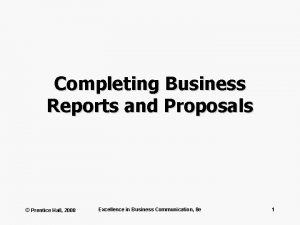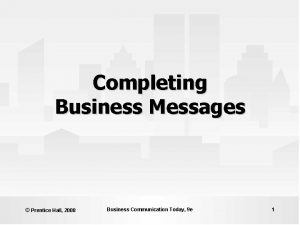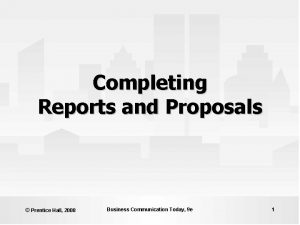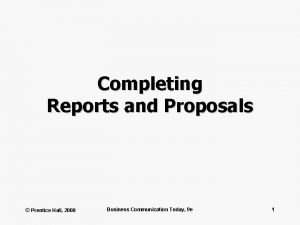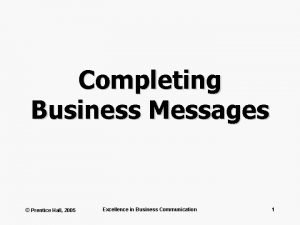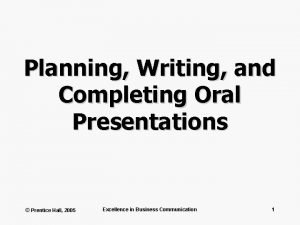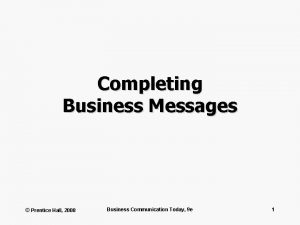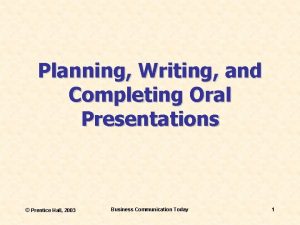Completing the Audit Chapter 23 2003 Prentice Hall





































- Slides: 37

Completing the Audit Chapter 23 © 2003 Prentice Hall Business Publishing, Auditing and Assurance Services 9/e, Arens/Elder/Beasley 23 - 1

Learning Objective 1 Conduct a review for contingent liabilities and commitments. © 2003 Prentice Hall Business Publishing, Auditing and Assurance Services 9/e, Arens/Elder/Beasley 23 - 2

Summary of the Audit Process Plan and design Phase I an audit approach. Phase II Perform tests of controls and substantive tests of transactions. Perform analytical procedures and Phase III tests of details of balances. Phase IV Complete the audit and issue an audit report. © 2003 Prentice Hall Business Publishing, Auditing and Assurance Services 9/e, Arens/Elder/Beasley 23 - 3

Phase IV – Completing the Audit Review for contingent liabilities Review for subsequent events Accumulate final evidence Evaluate results Issue audit report Communicate with audit committee and management © 2003 Prentice Hall Business Publishing, Auditing and Assurance Services 9/e, Arens/Elder/Beasley 23 - 4

Contingent Liabilities A contingent liability is potential future obligation to an outside party for an unknown amount resulting from activities that have already taken place. © 2003 Prentice Hall Business Publishing, Auditing and Assurance Services 9/e, Arens/Elder/Beasley 23 - 5

Likelihood of Occurrence and Financial Statement Treatment Likelihood of Financial Statement Occurrence of Event Treatment Remote (slight chance) No disclosure necessary Reasonably possible Footnote disclosure Probable Adjust financial statements OR footnote disclosure © 2003 Prentice Hall Business Publishing, Auditing and Assurance Services 9/e, Arens/Elder/Beasley 23 - 6

Auditor’s Concerns • Pending litigation for patent infringement, product liability, or other actions • Income tax disputes • Product warranties • Notes receivable discounted • Guarantees of obligations of others • Unused balances of outstanding letters of credit © 2003 Prentice Hall Business Publishing, Auditing and Assurance Services 9/e, Arens/Elder/Beasley 23 - 7

Audit Procedures for Finding Contingencies Inquire of management (orally and in writing) about the possibility of unrecorded contingencies. Review current and previous years’ internal revenue reports for income tax settlements. Review the minutes of directors’ and stockholders’ meetings for indications of lawsuits. © 2003 Prentice Hall Business Publishing, Auditing and Assurance Services 9/e, Arens/Elder/Beasley 23 - 8

Audit Procedures for Finding Contingencies Analyze legal expenses and review invoices and statements from legal counsel. Obtain a letter from each major attorney of the client as to the status of pending litigation. Review audit documentation for any information that may indicate a potential contingency. Examine letters of credit in force. © 2003 Prentice Hall Business Publishing, Auditing and Assurance Services 9/e, Arens/Elder/Beasley 23 - 9

Learning Objective 2 Obtain and evaluate letters from the client’s attorneys. © 2003 Prentice Hall Business Publishing, Auditing and Assurance Services 9/e, Arens/Elder/Beasley 23 - 10

Inquiry of Client’s Attorneys A list including (1) pending threatened litigation and (2) asserted or unasserted claims or assessments with which the attorney has had involvement. A request that the attorney furnish information or comment about the progress of each item listed. © 2003 Prentice Hall Business Publishing, Auditing and Assurance Services 9/e, Arens/Elder/Beasley 23 - 11

Inquiry of Client’s Attorneys A request for the identification of any unlisted pending or threatened legal action or a statement that the client’s list is complete. A statement informing the attorney of the attorney’s responsibility to inform management of legal matters requiring disclosure in the financial statements and to respond directly to the auditor. © 2003 Prentice Hall Business Publishing, Auditing and Assurance Services 9/e, Arens/Elder/Beasley 23 - 12

Learning Objective 3 Conduct a post-balance-sheet review for subsequent events. © 2003 Prentice Hall Business Publishing, Auditing and Assurance Services 9/e, Arens/Elder/Beasley 23 - 13

Period Covered by Subsequent Events Review Client’s ending balance sheet date Audit Date client report issues financial date statements 12 -31 -02 3 -11 -03 Period to which review for subsequent events applies 3 -26 -03 Period for processing the financial statements © 2003 Prentice Hall Business Publishing, Auditing and Assurance Services 9/e, Arens/Elder/Beasley 23 - 14

Types of Subsequent Events Those that have a direct effect on the financial statements and require adjustment Those that have no direct effect on the financial statements but for which disclosure is advisable © 2003 Prentice Hall Business Publishing, Auditing and Assurance Services 9/e, Arens/Elder/Beasley 23 - 15

Requiring Adjustment • Declaration of bankruptcy by a customer with an accounts receivable balance • Settlement of a litigation at an amount different from the amount recorded on the books © 2003 Prentice Hall Business Publishing, Auditing and Assurance Services 9/e, Arens/Elder/Beasley 23 - 16

Requiring Adjustment • Disposal of equipment not being used in operations at a price below the current book value • Sale of investments at a price below recorded cost © 2003 Prentice Hall Business Publishing, Auditing and Assurance Services 9/e, Arens/Elder/Beasley 23 - 17

Advisability of Disclosure • Decline in the market value of securities held for temporary investment or resale • Issuance of bonds or equity securities • Decline in the market value of inventory as consequence of government action barring further sale of a product • Uninsured loss of inventories as a result of fire • A merger or an acquisition © 2003 Prentice Hall Business Publishing, Auditing and Assurance Services 9/e, Arens/Elder/Beasley 23 - 18

Audit Tests Ø Inquiry of management Ø Correspond with attorneys Ø Review internal statements prepared subsequent to the balance sheet date Ø Review records prepared subsequent to the balance sheet date Ø Examine minutes issued subsequent to the balance sheet date Ø Obtain a letter of representation © 2003 Prentice Hall Business Publishing, Auditing and Assurance Services 9/e, Arens/Elder/Beasley 23 - 19

Dual Dating The first date is the date for the completion of field work except for a specific exception. The second date, which is always later, deals with the exception. © 2003 Prentice Hall Business Publishing, Auditing and Assurance Services 9/e, Arens/Elder/Beasley 23 - 20

Learning Objective 4 Design and perform the final steps in the evidence-accumulation segment of the audit. © 2003 Prentice Hall Business Publishing, Auditing and Assurance Services 9/e, Arens/Elder/Beasley 23 - 21

Final Evidence Accumulation 1. Perform final analytical procedures. 2. Evaluate the going-concern assumption. 3. Obtain a management representation letter. 4. Consider information accompanying the basic financial statements. 5. Read other information in the annual report © 2003 Prentice Hall Business Publishing, Auditing and Assurance Services 9/e, Arens/Elder/Beasley 23 - 22

Information Accompanying Basic Financial Statements Balance sheet Income statement Statement of cash flows Footnotes Basic financial statements Standard auditor’s report © 2003 Prentice Hall Business Publishing, Auditing and Assurance Services 9/e, Arens/Elder/Beasley 23 - 23

Information Accompanying Basic Financial Statements Detailed comparative statements Statistical data Schedule of insurance coverage Information accompanying basic financial statements Separate paragraph – unqualified, or disclaimer © 2003 Prentice Hall Business Publishing, Auditing and Assurance Services 9/e, Arens/Elder/Beasley 23 - 24

Learning Objective 5 Integrate the audit evidence gathered, and evaluate the overall audit results. © 2003 Prentice Hall Business Publishing, Auditing and Assurance Services 9/e, Arens/Elder/Beasley 23 - 25

Evaluate Results Sufficiency of evidence Evidence supports auditor’s opinion Financial statement disclosures Audit documentation review Independent review Summary of evidence evaluation © 2003 Prentice Hall Business Publishing, Auditing and Assurance Services 9/e, Arens/Elder/Beasley 23 - 26

Completing the Engagement Checklist YES NO 1. Examination of prior year’s audit documentation a. Were last year’s audit files examined for areas of emphasis in the current-year audit? ___ b. Was the permanent file reviewed for items that affect the current year? ___ © 2003 Prentice Hall Business Publishing, Auditing and Assurance Services 9/e, Arens/Elder/Beasley 23 - 27

Completing the Engagement Checklist YES NO 2. Internal control a. Has internal control been adequately understood? ___ b. Is the scope of the audit adequate in light of the assessed control risk? ___ c. Have all major weaknesses been included as reportable conditions in a letter to the audit committee or to senior management? ___ © 2003 Prentice Hall Business Publishing, Auditing and Assurance Services 9/e, Arens/Elder/Beasley 23 - 28

Completing the Engagement Checklist YES NO 3. General documents a. Where all current-year minutes and resolutions reviewed, abstracted, and followed up? ___ b. Has the permanent file been updated? ___ c. Have all major contracts and agreements been reviewed and abstracted and copied with all existing legal requirements? ___ © 2003 Prentice Hall Business Publishing, Auditing and Assurance Services 9/e, Arens/Elder/Beasley 23 - 29

Evaluating Results and Reaching Conclusions Actual audit evidence (by cycle, account, and objective) Evaluate results (by account and cycle) Audit procedures Sample size Items to select Timing Estimated misstatement (by account) Achieved audit risk (by account and cycle) © 2003 Prentice Hall Business Publishing, Auditing and Assurance Services 9/e, Arens/Elder/Beasley 23 - 30

Evaluating Results and Reaching Conclusions Evaluate overall financial statements Estimated misstatement (overall statements) Achieved audit risk (overall statements) Issue audit report © 2003 Prentice Hall Business Publishing, Auditing and Assurance Services 9/e, Arens/Elder/Beasley 23 - 31

Issue the Audit Report The audit report is the only thing that most users see in the audit process and the consequences of issuing an inappropriate report can be severe. © 2003 Prentice Hall Business Publishing, Auditing and Assurance Services 9/e, Arens/Elder/Beasley 23 - 32

Learning Objective 6 Communicate effectively with the audit committee and management. © 2003 Prentice Hall Business Publishing, Auditing and Assurance Services 9/e, Arens/Elder/Beasley 23 - 33

Communicate with the Audit Committee and Management Communicate fraud and illegal acts Communicate reportable conditions Other communication with audit committee Management letters © 2003 Prentice Hall Business Publishing, Auditing and Assurance Services 9/e, Arens/Elder/Beasley 23 - 34

Learning Objective 7 Identify the auditor’s responsibilities when facts affecting the audit report are discovered after its issuance. © 2003 Prentice Hall Business Publishing, Auditing and Assurance Services 9/e, Arens/Elder/Beasley 23 - 35

Period Covered by Subsequent Events Review Client’s ending balance sheet date 12 -31 -02 Audit report date Date client issues financial statements 3 -11 -03 3 -26 -03 Period to which Period for review for processing subsequent the financial events applies statements Period in which subsequent discovery of facts is made © 2003 Prentice Hall Business Publishing, Auditing and Assurance Services 9/e, Arens/Elder/Beasley 23 - 36

End of Chapter 23 © 2003 Prentice Hall Business Publishing, Auditing and Assurance Services 9/e, Arens/Elder/Beasley 23 - 37
 Pearson education inc publishing as pearson prentice hall
Pearson education inc publishing as pearson prentice hall 2008 pearson prentice hall inc
2008 pearson prentice hall inc 2008 pearson prentice hall inc
2008 pearson prentice hall inc 2005 pearson prentice hall inc
2005 pearson prentice hall inc Pearson prentice hall
Pearson prentice hall Prentice hall inc
Prentice hall inc Prentice hall careers
Prentice hall careers Prentice hall america pathways to the present
Prentice hall america pathways to the present 2011 pearson education inc
2011 pearson education inc Prentice hall business publishing
Prentice hall business publishing Prentice hall african american history
Prentice hall african american history Prentice hall physical science: concepts in action
Prentice hall physical science: concepts in action Pearson education inc publishing as pearson prentice hall
Pearson education inc publishing as pearson prentice hall Pearson prentice hall
Pearson prentice hall Pearson prentice hall
Pearson prentice hall 2005 pearson prentice hall inc
2005 pearson prentice hall inc Pearson education inc publishing as pearson prentice hall
Pearson education inc publishing as pearson prentice hall Arthropods common name
Arthropods common name Prentice hall business publishing
Prentice hall business publishing Pearson education inc. publishing as prentice hall
Pearson education inc. publishing as prentice hall Pearson education, inc. publishing as prentice hall
Pearson education, inc. publishing as prentice hall Pearson 2012
Pearson 2012 Chapter 4 job costing
Chapter 4 job costing 2011 pearson education inc
2011 pearson education inc Pearson education inc. publishing as prentice hall
Pearson education inc. publishing as prentice hall Pearson education 2010
Pearson education 2010 Pearson education inc. publishing as prentice hall
Pearson education inc. publishing as prentice hall Perbedaan audit konvensional dengan audit berbasis risiko
Perbedaan audit konvensional dengan audit berbasis risiko Audit informasi klinis
Audit informasi klinis Beda audit medis dan audit klinis
Beda audit medis dan audit klinis Penyelesaian audit dan tanggung jawab pasca audit
Penyelesaian audit dan tanggung jawab pasca audit Hubungan ekonomisasi efisiensi dan efektivitas
Hubungan ekonomisasi efisiensi dan efektivitas Prosedur audit bottom-up dan audit top-down!
Prosedur audit bottom-up dan audit top-down! Auditing definition
Auditing definition Perbedaan audit konvensional dengan audit berbasis risiko
Perbedaan audit konvensional dengan audit berbasis risiko Audit is derived from
Audit is derived from Internal audit universe
Internal audit universe Overall audit plan and audit program
Overall audit plan and audit program

